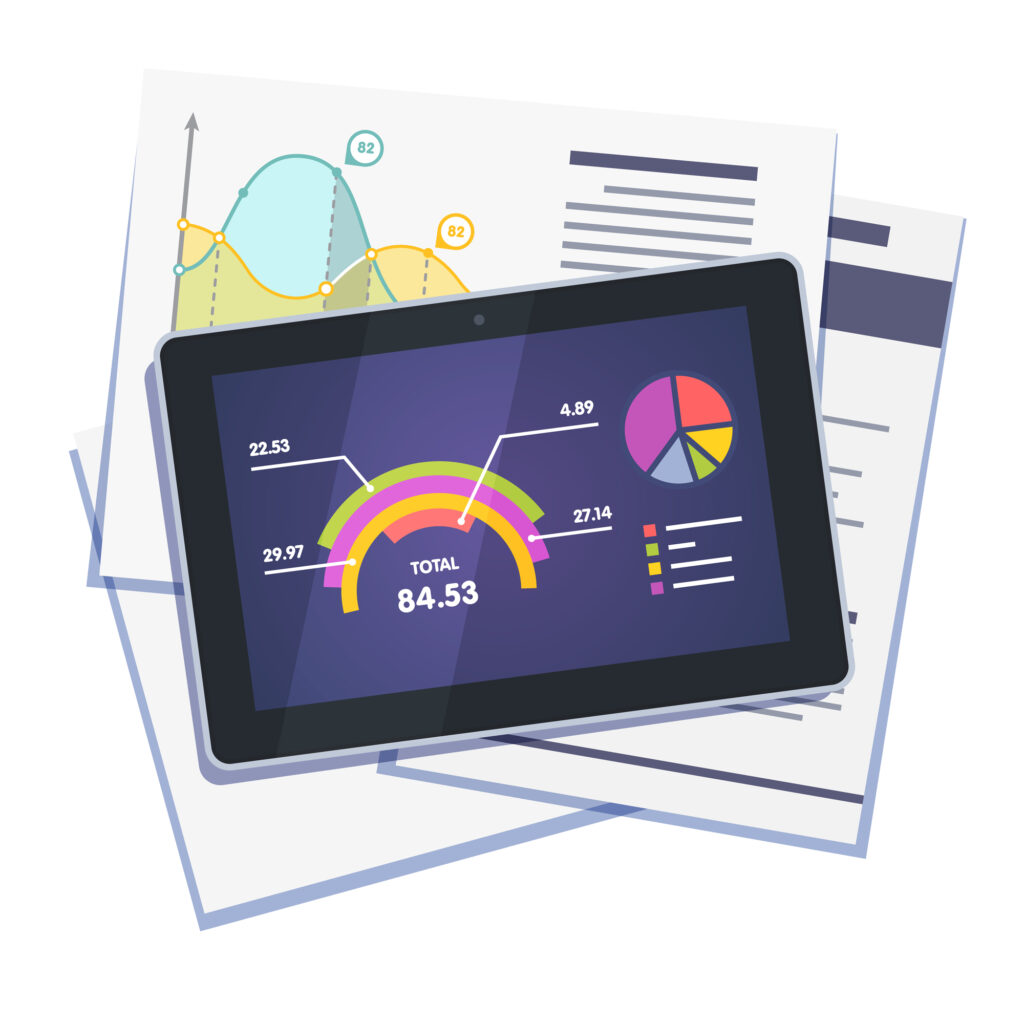One of the most crucial elements of any successful project is data-driven analytics. You can increase your chances of succeeding in accomplishing your goals and objectives by using data to inform your decisions. This blog article will discuss the value of data-driven analytics and how it can be applied to enhance project outcomes. We will also offer advice on using data-driven analytics in your initiatives.
Projects are getting more complicated, and data is helping firms make sense of this complexity in a big way. Making decisions regarding projects in the past required decision-makers to rely on their own experience and instincts. However, decision-makers now have access to a wealth of data that may be used to enhance project results thanks to the development of data-driven analytics.
You can approach decision-making scientifically thanks to data-driven analytics. You may increase your chances of success by utilizing data to test hypotheses and track outcomes as you make decisions. Furthermore, data-driven analytics can assist you in avoiding frequent errors that might happen when making decisions only based on experience or intuition.
Data-driven analytics can be implemented in a variety of ways. Utilizing data mining and modeling tools to find patterns and relationships in your data is one approach to go about it. You can also evaluate your data and forecast future results using statistical techniques. Machine learning algorithms can also automatically find patterns in your data.
Whether you decide to start, data-driven analytics is a crucial component of any successful project. You can increase your chances of succeeding in accomplishing your goals and objectives by using data to inform your decisions. You can advance your projects by using the appropriate tools and methods.

How can you manage or optimize your business if you do not measure your data?
Any project will inevitably include dangers, but a skilled manager can guide you through them. Project managers should employ analytical skills to precisely anticipate a project’s schedule and cost. Everyone involved in the project can assess its progress objectively and make decisions.
Why is Analytics Important in Project Management?
By leveraging analytical reports and drill-down charts, project managers can leverage data-driven analytics to make more informed decisions regarding upcoming projects. Teams can manage their resources more effectively, comprehend historical trends and patterns, and raise their chances of success with this strategy.
How can project managers use a data-driven approach to improve project outcomes?
-Capturing Projections and Early Signals
No matter how big or small a business is, statistics are crucial. Management and executives can utilize analytics to take preventative action and seek early indicators of budget overruns, costs, and deadlines. Managers can track progress with analytics to accurately forecast if a project will be finished on schedule. A burn-down chart is a form of a graphic display showing the amount of work still unfinished at different times.
Analytics is a helpful tool for identifying pertinent data patterns, but it may also be used to forecast sales and expenditures and optimize resource utilization. Businesses can notice possible red flags early on while still being able to comprehend complex projects by using a thorough approach to data.
-Quality of Deliverable
Numerous moving pieces in a new project make it challenging to assume control. Analytics has become a crucial part of contemporary project management to keep track of everything.
Aim for quality to improve your chances of completing a job successfully. By immediately identifying problems, analytics can help you minimize your workload and enhance your project’s processes and results. You can address issues before they have a chance to affect the caliber of your delivery by gathering data at every stage of the project.
-Assisting Strategic Decisions
Analytics benefit companies by providing them with the information they can utilize to make better decisions. Project analytics in real-time give businesses information they can use to succeed. Managers and executives can also use analytics to determine how individual initiatives fit into the more comprehensive portfolio and corporate strategy.

Use of Data Analytics in improving Project Management controls
I’ve tried to communicate my knowledge based on my experience in project design and management as a Project Management Professional (PMP) and a Data Science enthusiast. In this post, you will learn how to leverage data analytics to enhance project management controls while the project is being developed.
It takes judgment to handle a project. Data mining and machine learning methods based on project data analysis and selection may improve decisions and address some frequent project challenges.
Any organization needs data to function. Managers can use analytics to look for early warning signs of problems with timelines, costs, or budgets and take preventative action. Managers can more precisely forecast whether a project will be finished on schedule by using analytics to track the task completion rate. Burn-down charts, for instance, are one method of displaying this data over time.
Advanced analytics may also help you forecast income and expenses and optimize resource use. With analytics, businesses may adopt a more global perspective and connect various data streams to offer rich insights into project estimates and early indicators. The Program Management Office (PMO) may perform this duty.
How can project managers use a data-driven approach to improve project outcomes?
According to Gartner, artificial intelligence will assume the role of humans in 80% of project management duties. AI won’t take over human professions any time soon, but it will help decision-making and guarantee projects are finished on schedule and under budget. Machine learning algorithms handle data collecting, tracking, reporting, and other conventional project management tasks.
The duties of a project manager will alter as society develops. Project management has changed throughout time, from overseeing activities to meeting deadlines. The project manager position may become more important as artificial intelligence (AI) is used more frequently in the industry. Although AI can generate reports and automate tedious jobs, it cannot replace people. To ensure effective project outcomes, project managers will still be in charge of crucial tasks, including gathering requirements and stakeholder support. Businesses that use AI should learn how to manage projects effectively by combining machine learning and human involvement.
Those who don’t adapt to the times are frequently left behind as artificial intelligence gradually gains popularity. Therefore, it is your responsibility as a technical project manager to understand how AI initiatives differ from other types of projects and discover what steps you can take to position yourself for this shifting environment. Additionally, you’ll be able to run a digital program office much more effectively in the future if you grasp machine learning models now.
Project managers have the resources to regularly track performance data and make wiser decisions thanks to data analytics. To increase the success rate of future initiatives, executives can decide how resources are used and what strategic decisions need to be made by using the essential insights provided by a data-driven analytics approach.
The success of any organization depends on data. With the use of analytics, managers and executives can proactively spot early signs of budget slippage, costs, timeframes, etc.. Analytics also makes tracking labor rates simple, improving forecasting of project completion deadlines. A burn-down chart, for instance, graphically displays the amount of work that needs to be done over time.
In-depth analytics can also assist you in resource optimization and more precise forecasting of revenue and expenses. Businesses can assess many data sets simultaneously by employing analytics in decision-making to get a clear view of developments and problems in complicated projects.
-Data Analytics in Project Management
By taking lessons from the past, we can make the future better. As project managers, we must use earned value management to foresee the intended course of action going forward and connect the dots while looking backward. This will indicate whether or not the current course and tempo are meant to achieve the desired result. We can assist in identifying modifications that must be made to effectively complete the project by reviewing previous performance and considering the amount of work still to be done. The project manager must always strike a balance between meeting the constraints set forth at the beginning of a project and continuing to exercise control over its course. He must achieve this by often checking in on important Project Performance Indicators.
Due to the Triple Constraints, project management has grown more complex and will only worsen over the next ten years. Reduced product development periods, altered consumer expectations, and skyrocketing internet usage are a few variables that have increased complexity.
Digitization is one method for dealing with complexity and the need to adapt to a changing reality. Thanks to the digitization of project development phases, stakeholders will have the most effective access to all linked databases, enabling them to base managerial decisions on the information. This database can anticipate and effectively handle the following risks to project performance metrics – time, money, and quality. In addition to offering a wide picture for managerial decisions, the Portfolio Dashboard also has a real-time aspect that allows global access and collaboration.

How can you manage or optimize your business if you do not measure your data?
Project management is challenging since there are many risks and unknowns. Project managers must employ analytical techniques to control these risks and make precise cost and timetable predictions. Project managers can evaluate, watch, and objectively assess performance using data analytics while making fact-based judgments.
Organizations can create more value strategically if they digitize their project management processes and use analytics.
-Project Analytics:
Analyzing data to derive insights that can be applied to better decision-making is called analytics. A group of individuals with knowledge of multiple analytical disciplines, such as statistical and operational research methods, Lean Six Sigma, and software programming, are often involved in this. Even though the analysis and analytics of the phrase are frequently used synonymously, they have distinct meanings.
Project managers who want to take on more complex projects while staying within budget and organized can benefit from the data branch known as project analytics. They can track the project’s development and determine whether it is accomplishing its objectives by employing analytics. They can use this knowledge to make better judgments for future initiatives, leading to a higher success rate.
-Quality of Deliverable
Utilize these straightforward recommendations to begin a new project confidently. Maintaining order may be difficult when a project has many moving parts. Modern project managers can benefit from analytics in this scenario. Due to biased decision-making, which is the tendency for decision makers to favor information that supports their current beliefs, they may only concentrate on one answer rather than carefully analyzing all of their possibilities. When you undertake your next major project, keep this in mind!
The project manager must understand how analytics can not only lighten her job but also improve the project’s processes and outcomes, as she is the one responsible for overseeing the work of others and reporting to them. Quality is only a temporary sign of success; the success or failure of your project is determined by evaluation after delivery. As a result, for your project to be successful, analytics must be used at every stage, from planning to execution.
-Assisting Strategic Decisions
Businesses can use analytics to base choices on data rather than intuition. Real-time project analytics give enterprises a plethora of knowledge that helps them align with their long-term goals. Analytics may help CEOs and executives understand how current and future projects fit into the entire portfolio and business strategy.
-Lowers project costs
Big data analytics is a technique for accumulating increasing data to forecast future events and trends in your industry easily. As a result, resource planning and forecasting will move more quickly since you’ll have a ready-to-use library of pertinent data and a better understanding of your project’s budget, timetable, estimates, and other requirements.
By identifying and categorizing the jobs that your team members excel at, analysis of massive data may help you produce your content more rapidly by providing your team with precise information that will enable them to carry out their tasks successfully. This reduces the possibility of project errors and blunders, which could cost time and money and offer a chance for days, weeks, or months to fix if not addressed right away.
-Improves resource management
Data analytics enables you to comprehend your project requirements by extracting pertinent information. Data analytics can be used to evaluate resources in terms of efficient resource allocation, determine how much is accessible, and uncover strategies to enhance project operations. Your deadline and available resources may be significantly impacted by the movable parts and changes in project management, such as your budget.
You can get the knowledge and resources you need to make wise judgments about modifying the project plan from considerable data insights and resource management systems. It can also help with decision-making about resource allocation and project forecasts.
-Enhances project risk management
Fast-paced and constantly changing, project management is influenced by internal and external factors. This makes it susceptible to several dangers that could imperil your capacity to finish the project on schedule.
To correctly manage the risks associated with your project, every conceivable risk event and the steps taken to mitigate those risks must be documented. By assisting you in understanding past problems and seeing possible problems early on, data analytics may help you examine past issues and prevent them in the future. You may also use the proper techniques and tools to spot potential dangers early on and formulate strategies for effectively countering them.

What is Data-Driven Analytics?
When data, rather than judgment or experience, informs business decisions, this process is called data-driven analytics. Businesses that employ this strategy notice an increase in success rates. The most significant advantage of data-driven analytics is that it removes decision makers’ bias from prior experiences or preconceptions. This ultimately results in the organization making better decisions overall.
Data-driven analytics can help companies identify cost-saving strategies in addition to improving accuracy. When a business wants to launch a new product, it first uses data analytics to determine whether there is a market for the possible offering. Having this knowledge beforehand could potentially help save time by delaying production or marketing if necessary. Although data-driven analytics provides benefits, there are some challenges as well. Although essential, the data’s accuracy and timeliness can frequently be challenging. Businesses must ensure that their team has the necessary expertise and skill set since analysts who interpret the data are crucial to its success.
Despite these challenges, data-driven analytics is swiftly becoming necessary for businesses of all kinds. The project outcomes of those who employ this technique are likely to improve. Make sure your team has the right knowledge and expertise when using data-driven analytics. If you have the right team, leveraging data-driven analytics may help you enhance project results and success.
The importance of being data-driven
We now recognize the advantages of data-driven procedures for each division and component of competitive businesses. The more data you have, the more crucial it is to be able to organize and assess all of the available data. The sheer volume of information would be more of a burden than a help.
You may streamline your operations, improve reach, and increase conversions by processing the data you gather from your marketing campaigns. Data-driven businesses are discovering that marketing data may also be helpful for sales and product development. Companies that rely on data to guide their decisions are working to connect all data sources to optimize the performance of each department.
Companies can give their customers a better experience when data is shared between departments. For instance, the sales team can better target contact with potential customers if they have access to data obtained during the marketing process. Billing can find strategies to increase customer satisfaction levels throughout the revenue cycle management process if they know what transpired during customer service encounters.
The final client is at the center of each scenario’s process. You can answer key questions about your clients, their needs, and their pain points with the help of data collection and analysis. This information enables you to tailor client service and foresee needs more successfully. These benefits equate to better treatment, improved conversion rates, and an edge in winning over clients’ confidence and loyalty.

How to use data analytics tools and techniques
Only if you can effectively analyze and use the data you’ve gathered is data-driven technology beneficial. Tools and procedures for data analytics are helpful in this situation. Marketers use several tools and platforms to collect the necessary data and provide reports that aid decision-making.
Online marketing makes data analytics simple because all the obtained data can be quickly and readily inputted. But clever marketers know that having content management systems record every customer interaction with the brand gives them a significant advantage over their rivals. This could include digital capture tools to preserve textual letters, emails, surveys, and touchpoints from in-person interactions in physical locations.
As we’ve seen with retail transactions, many companies gather email addresses and other details from cashiers to upsell customers and include them in the marketing cycle. Marketers use innovative strategies to link all of a customer’s brand encounters.
There are many possible uses for this data. It helps the marketing division personalize messaging to improve customer loyalty and communication with each unique customer. The data enables a more comprehensive picture of the company’s overall conversion rates, the success of each specific campaign, and marketing performance. The information might then pinpoint areas where staff members can improve. Businesses may do this to enhance their processes as markets continuously change consumer demands.
Marketing automation solutions, like those from Hubspot, Marketo, or Salesforce, are some of the resources marketers employ to accomplish these goals. For a more thorough understanding of campaigns across numerous channels, social media platforms can be combined with cross-channel analytic tools utilized by marketers. Additionally, marketers use data from customer surveys and interactions, email campaign stats, and web property analytics.
What are data-driven insights?
Data-driven insights typically refer to authentic and verifiable information about your clients. These data points are not often fixed ones, though. For instance, it is not an insight if you find that a portion of your audience is female and 35 years old. However, this would be a fantastic insight if you also discover that your 35-year-old female audience members are culturally invested in a movement for female empowerment.
Your understanding is fact-based once you’ve done your investigation on the data. These facts could originate from several places. You might utilize your marketing attribution or third-party statistics from effective marketing and governmental agencies to combine the data. You might gain a fresh perspective thanks to the mix of such data and corporate information.
You can gain insights by probing the current problem you face in your marketing strategy. For instance, you might be considering how to increase social media sharing of your brand and messaging. You would begin by examining your current followers and the content they do share. It could be helpful to assess where competitors have found success by comparing them to your own. Data showing that a significant portion of this core group shares a particular kind of article could provide you with your insight.

How can data-driven analytics help improve project outcomes?
Decision-makers frequently lack access to the proper data, leading to project failure. By offering insights based on data and evidence, data-driven analytics can aid your decision-making.
The proper data needs to be gathered first. Numerous sources, including project management software, financial records, and client feedback, can provide this information. Once you have this information, you must analyze it to look for patterns and trends.
This research can pinpoint your project’s strong points and development opportunities. With this knowledge, you can make your project adjustments to raise the likelihood of success. Analytics based on data is essential for projects to succeed. You may enhance project outcomes and steer clear of expensive errors by using data to inform your decisions.
The increasing importance of data-driven analytics in project management
According to recent research by the Project Management Institute, businesses that use data-driven analytics have a double-double chance of achieving their project objectives.
This is understandable given that data-driven analytics can offer insights into a project’s cost, schedule, risks, and prospects.
Businesses that do not use data-driven analytics are at a competitive disadvantage because they do not use the advantages that these insights offer.
There are several ways to use data-driven analytics to improve project outcomes.
Analysts can first aid in identifying trends and patterns in project data to make better decisions.
For instance, analysts can assist in determining which projects are most likely to run late or over budget and offer suggestions on preventing these issues.
Secondly, project planning can be enhanced by data-driven analytics.
Analysts can create models that forecast future projects’ development by studying data from completed initiatives.
This data can develop precise project plans and spot potential dangers and pressing problems.
Third, project performance can be tracked via data-driven analytics.
Analysts may assist firms in taking remedial action to prevent expensive delays and interruptions by monitoring important project indicators, which enables them to spot problems and concerns early on.
Fourth, project outcomes can be assessed using data-driven analytics.
Analyzing project data enables analysts to pinpoint areas for improvement and offer suggestions for how to improve outcomes in upcoming initiatives.

The benefits of data-driven analytics for improving project outcomes
By offering otherwise unavailable insights and assisting in optimizing resources and processes, using data to drive, decision-making can help projects perform better.
Nevertheless, despite the apparent benefits of utilizing data-driven analytics, many organizations have difficulty putting these tools and methods into practice. According to a recent survey, only 26% of firms claim to be very effective at using data to inform their decisions.
Organizations have trouble using data-driven analytics efficiently for a variety of reasons. One frequent issue is that data is frequently dispersed across many silos inside a business, making it challenging to acquire a comprehensive picture of what’s happening. Additionally, many firms lack the knowledge and experience to employ data-driven analytics successfully.
Despite these obstacles, organizations can take various actions to enhance their usage of data-driven analytics. Investing in staff training to ensure they have the abilities and information required to use these tools effectively is a crucial first step. For data-driven analytics projects, it’s also critical to set clear goals and objectives and get senior leaders on board.
Organizations can increase their chances of using data-driven analytics successfully and eventually enhance project outcomes by following these steps. By offering otherwise unavailable insights and assisting in optimizing resources and processes, using data to drive, decision-making can help projects perform better.
Conclusion
One of the most crucial elements of any successful project is data-driven analytics. You can increase your chances of succeeding in accomplishing your goals and objectives by using data to inform your decisions. This blog article discusses the value of data-driven analytics and how to apply it to enhance project outcomes. Additionally, we have offered some advice on how to begin using data-driven analytics in your initiatives. Consider employing data-driven analytics as part of your decision-making process if you’re seeking a technique to increase the success of your subsequent project.























